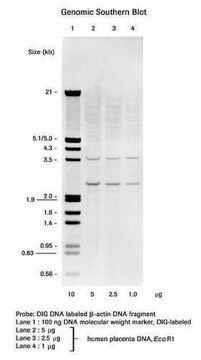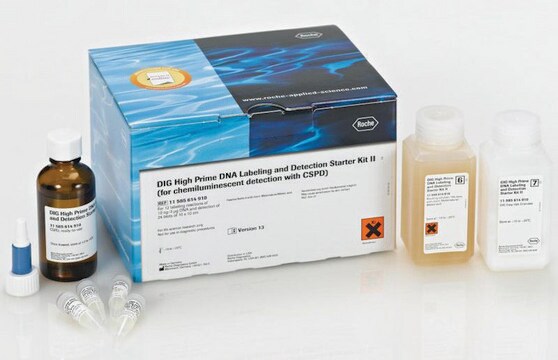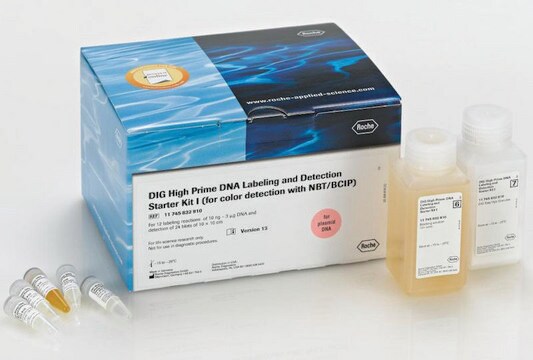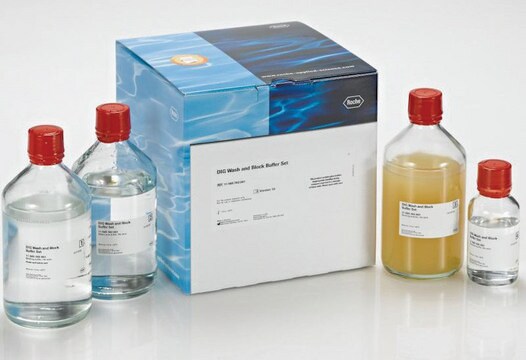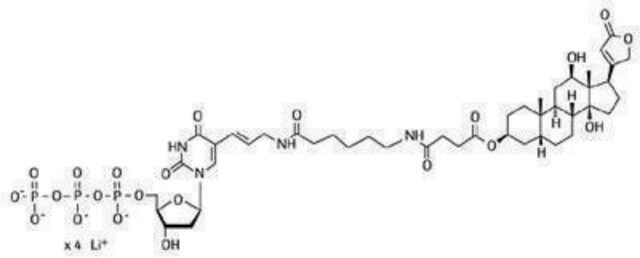おすすめの製品
使用法
sufficient for 25 reaction (50 μL final reaction volume)
品質水準
メーカー/製品名
Roche
テクニック
PCR: suitable
保管温度
−20°C
詳細
PCR DIG プローブ合成キットには、アルカリに不安定なジゴキシゲニン(DIG)-11デオキシウリジン三リン酸(dUTP)が含まれています。このキットは、ポリメラーゼ連鎖反応(PCR)において感受性の高いプローブである、DIG標識化DNAプローブを簡便かつ効率的に生成します。プローブは、PCRの手法により、(アルカリに不安定な)DIG-11dUTPで標識されます。DIG-dUTPとdTTPの比率は1:2です。
PCR DIGプローブ合成キットには、Expand High Fidelity DNAポリメラーゼミックスが含まれています。プルーフリーディング活性を有する、この堅牢な酵素ミックスは、10 pgプラスミドDNAと10 ngゲノムDNAをテンプレートとして用いて、長さ40 bpから5 kbまでのプローブを重合します。DIG標識化プローブは、1年以上安定です。
PCR DIGプローブ合成キットには、Expand High Fidelity DNAポリメラーゼミックスが含まれています。プルーフリーディング活性を有する、この堅牢な酵素ミックスは、10 pgプラスミドDNAと10 ngゲノムDNAをテンプレートとして用いて、長さ40 bpから5 kbまでのプローブを重合します。DIG標識化プローブは、1年以上安定です。
アプリケーション
PCR DIGプローブ合成キットにより生成されたジゴキシゲニン(DIG)標識化DNAプローブは、サザンブロット法およびノーザンブロット法においてまれなmRNAの低(単一)コピー遺伝子の検出に適しています。DIG標識化DNAプローブは、in situでのハイブリダイゼーション中にDNAを標識することにも使用されています。
提供されるdUTP-ヌクレオチドミックスの濃度は、プローブの長さによって調節できます。標識化の効果は、アガロースゲル上で迅速に確認できます。
膜の剥離と再プローブは、添付文書のプロトコールに従って複数回行うことが可能です。
1回のPCR標識反応(50 μL)により通常、20 mLのハイブリダイゼーション溶液に十分なプローブが作成されます。本キットは、約25回分の反応(50 μL)に使用できます。
提供されるdUTP-ヌクレオチドミックスの濃度は、プローブの長さによって調節できます。標識化の効果は、アガロースゲル上で迅速に確認できます。
膜の剥離と再プローブは、添付文書のプロトコールに従って複数回行うことが可能です。
1回のPCR標識反応(50 μL)により通常、20 mLのハイブリダイゼーション溶液に十分なプローブが作成されます。本キットは、約25回分の反応(50 μL)に使用できます。
包装
1つのキットには6のコンポーネントが含まれています。
品質
PCR DIGプローブ合成キットの各ロットは、PCRによって機能テスト済みです。増幅生成物は、ゲノミックサザンブロットにおいて分析されます。
パッケージ内の説明書に記載のPCR条件において、コントロール反応により、442 bpの増幅生成物が得られます。PCRプロセスにおける複数のDIG-dUTPの取り込みにより、PCR生成物の分子量は、非標識の場合と比べて大幅に増加します。10 μgのヒトゲノムDNAのPCR生成物のハイブリダイゼーション後、化学発光検出により、特定のフラグメントパターンが検出されます。
パッケージ内の説明書に記載のPCR条件において、コントロール反応により、442 bpの増幅生成物が得られます。PCRプロセスにおける複数のDIG-dUTPの取り込みにより、PCR生成物の分子量は、非標識の場合と比べて大幅に増加します。10 μgのヒトゲノムDNAのPCR生成物のハイブリダイゼーション後、化学発光検出により、特定のフラグメントパターンが検出されます。
キットの構成要素のみ
製品番号
詳細
- Enzyme Mix, Expand High Fidelity 3.5 U/μl
- PCR DIG Probe Synthesis Mix, containing dATP, dCTP, dGTP (2 mM each) 10x concentrated
- PCR Buffer with MgCl2 10x concentrated
- dNTP Stock Solution, containing dATP, dCTP, dGTP, dTTP (2 mM each), pH 7.0 10x concentrated
- Control Template, plasmid DNA in Tris/EDTA buffer, pH 8.0. The 5-kb plasmid contains the cDNA for the human tissue-type plasminogen activator (tPA) 20 pg/μl
- Control PCR Primer Mix, containing 50 pmol of each primer, control PCR primer 1 and 2 2 mM each
よく一緒に購入される製品
危険有害性情報
注意書き
危険有害性の分類
Aquatic Chronic 3
保管分類コード
12 - Non Combustible Liquids
WGK
WGK 2
引火点(°F)
does not flash
引火点(℃)
does not flash
試験成績書(COA)
製品のロット番号・バッチ番号を入力して、試験成績書(COA) を検索できます。ロット番号・バッチ番号は、製品ラベルに「Lot」または「Batch」に続いて記載されています。
この製品を見ている人はこちらもチェック
Jose Arturo Gutierrez-Triana et al.
eLife, 7 (2018-08-30)
CRISPR/Cas9 efficiently induces targeted mutations via non-homologous-end-joining but for genome editing, precise, homology-directed repair (HDR) of endogenous DNA stretches is a prerequisite. To favor HDR, many approaches interfere with the repair machinery or manipulate Cas9 itself. Using Medaka we show
Chien-Yuan Lin et al.
Plant methods, 13, 113-113 (2017-12-23)
Switchgrass (Panicum virgatum), a robust perennial C4-type grass, has been evaluated and designated as a model bioenergy crop by the U.S. DOE and USDA. Conventional breeding of switchgrass biomass is difficult because it displays self-incompatible hindrance. Therefore, direct genetic modifications
Claudia Sigl et al.
Applied and environmental microbiology, 77(3), 972-982 (2010-12-15)
In filamentous fungi, secondary metabolism is often linked with developmental processes such as conidiation. In this study we analyzed the link between secondary metabolism and conidiation in the main industrial producer of the β-lactam antibiotic penicillin, the ascomycete Penicillium chrysogenum.
Takato Sugiyama et al.
Cell reports, 26(12), 3400-3415 (2019-03-21)
18S non-functional rRNA decay (NRD) eliminates non-functional 18S rRNA with deleterious mutations in the decoding center. Dissociation of the non-functional 80S ribosome into 40S and 60S subunits is a prerequisite step for degradation of the non-functional 18S rRNA. However, the mechanisms
N Toplu et al.
Veterinary pathology, 48(3), 576-583 (2010-05-13)
The present study describes the pathologic changes and cellular apoptosis in the central nervous system (CNS) of fetal and neonatal small ruminants infected with border disease virus (BDV), as demonstrated by immunohistochemistry and in situ hybridization. Abortions of ewes and
資料
Digoxigenin (DIG) labeling methods and kits for DNA and RNA DIG probes, random primed DNA labeling, nick translation labeling, 5’ and 3’ oligonucleotide end-labeling.
Digoxigenin (DIG) labeling methods and kits for DNA and RNA DIG probes, random primed DNA labeling, nick translation labeling, 5’ and 3’ oligonucleotide end-labeling.
ライフサイエンス、有機合成、材料科学、クロマトグラフィー、分析など、あらゆる分野の研究に経験のあるメンバーがおります。.
製品に関するお問い合わせはこちら(テクニカルサービス)
